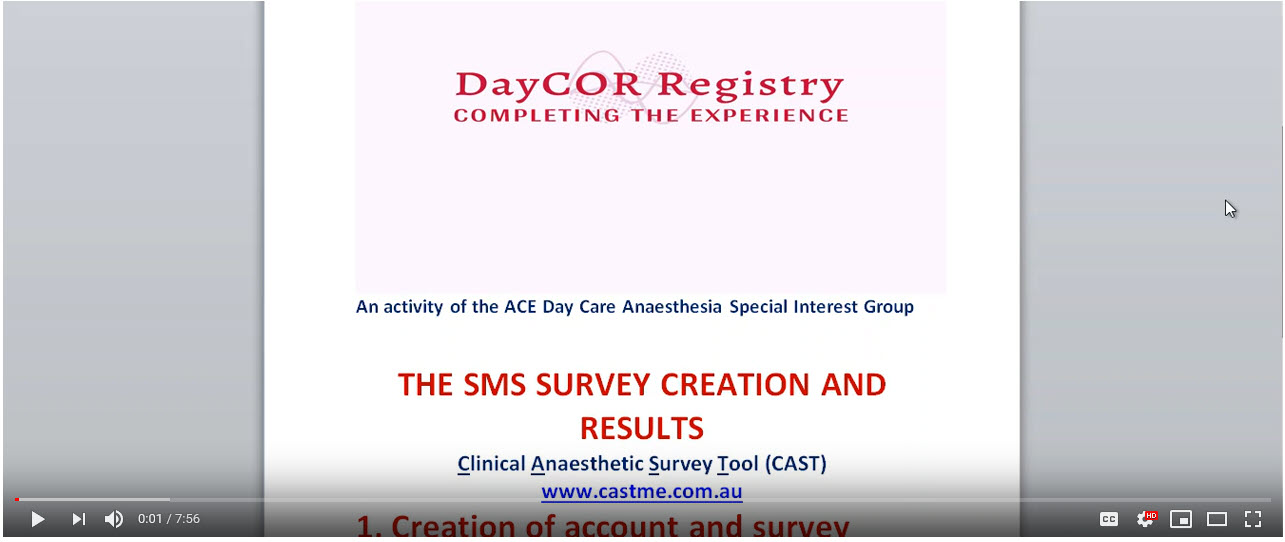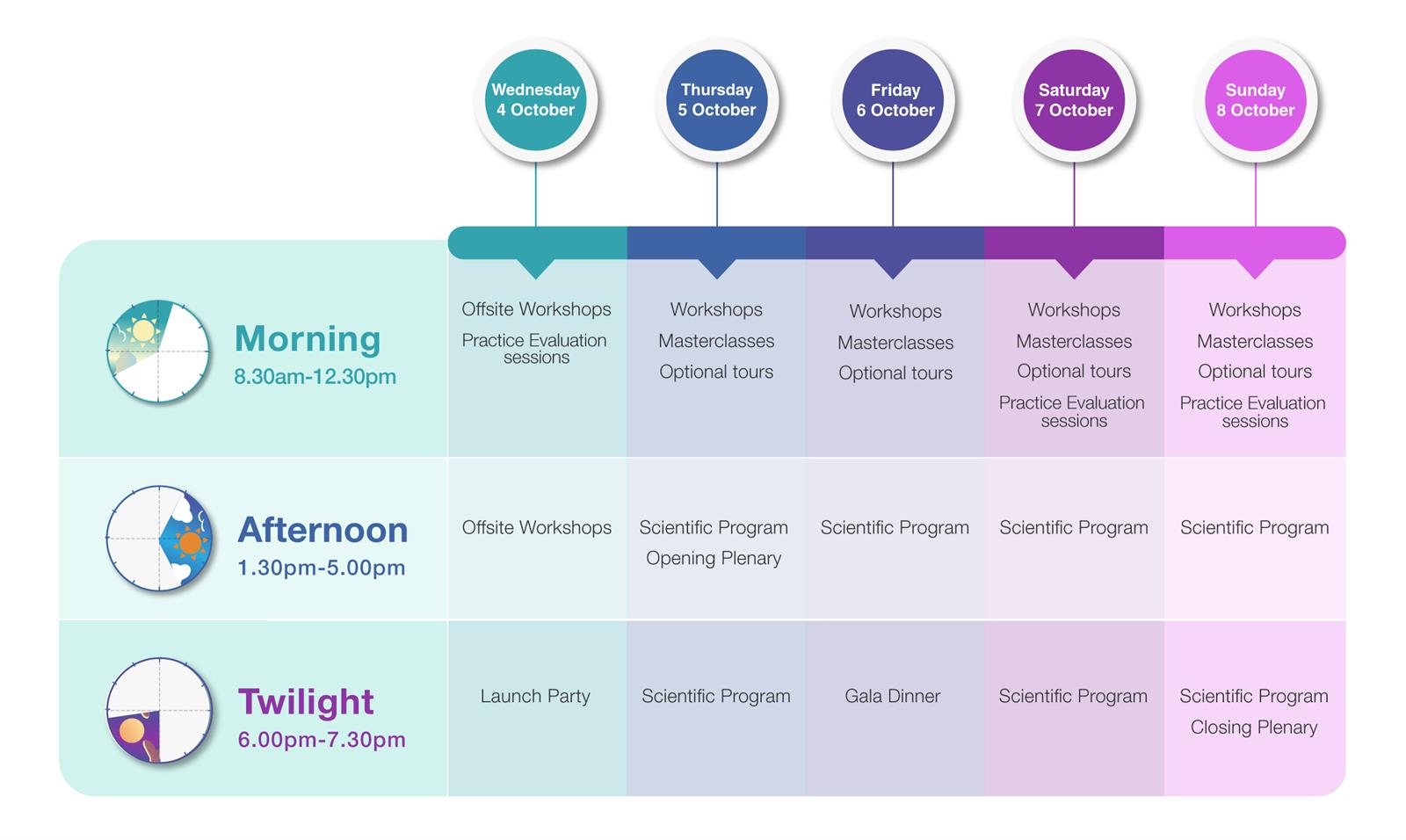Day Care Anaesthesia Special Interest Group
OBJECTIVE
The Day Care Anaesthesia SIG aims to promote science and education through the exchange of ideas between anaesthetists with a particular interest and involvement in day care anaesthesia and the interaction with other individuals / groups, who share an interest in day care anaesthesia.
The SIG has about 1000 registered members.
The executive of the Day Care Anaesthesia SIG meets regularly, usually via teleconference, to discuss matters related to the group's area of interest. Please feel free to contact any of the listed executive members.
|
 |
 Follow us on Twitter for all the latest news @daycor_registry
Follow us on Twitter for all the latest news @daycor_registry
 Watch our video presentation on DayCOR Registry Preliminary Steps
Watch our video presentation on DayCOR Registry Preliminary Steps
ACTIVITIES
The activities of the SIG may include:
- Organising SIG scientific sessions at major annual scientific meetings / congresses and other independent SIG meetings.
- Organising independent SIG meetings on other occasions with the approval of the Anaesthesia Continuing Education Co-ordinating Committee (ACECC).
- Providing a resource with respect to the appropriate standards of care in the area of special interest.
- Providing advice to Anaesthesia Continuing Education on the distribution of educational material and to ANZCA, the Australian Society of Anaesthetists or the New Zealand Society of Anaesthetists on liaison with similar organisations in other regions of the world.
DAY CARE ANAESTHESIA OUTCOMES REGISTRY, THE DayCOR REGISTRY
The Day Care Anaesthesia SIG is developing a Registry (DayCOR Registry) of outcomes of day
care anaesthesia.
We invite
anaesthetists to request their hospitals to participate, particularly as we
release the beta version of the program for use and appraisal.
An SMS survey software program has been developed enabling anaesthetists to investigate and record the outcomes of their day care cases. It is hospital based, with reports being available to the patient’s anaesthetist and hospital.
ALERTS generated by unfavourable survey answers, are emailed immediately to the anaesthetist and hospital for action.
The information will be de-identified then entered into a registry from which reports can be generated for individual anaesthetist, hospitals, health departments and the public
This survey has a specific set of questions to be answered. Once these have been fully evaluated, there will be opportunities for additions or new small subsets of questions.
The Registry complies fully with guidelines developed for the Health Ministers Advisory Council by the Australian Commission on Safety and Quality in Health Care. In particular, this provides absolute safety and privacy of the information.
The reasons and methods of development are covered in the accompanying presentation (below) but in summary:
- There is a paucity of data
surrounding any unfavourable outcomes of same day surgery and procedures.
- The number of work-days lost and the economic impact of this loss is unknown.
- Unfavourable outcomes could impact on their partner’s or other members of their family’s ability to attend work.
- There is a growing tendency to attempt more advanced procedures and operate on older and sicker patients as day care cases
- Whilst the surgeon or proceduralist always reviews their patients, most are lost to follow up by their anaesthetist and the great majority of unfavourable outcomes will occur in the first few days after, usually before any review is undertaken.
- Hospitals and Clinicians will be able to compare outcomes within their institutions, or with other institutions prepared to share anonymous data pooled on a central server.
- This is an EDUCATIONAL program with the ultimate aim of improving outcomes, particularly with new procedures or with the moving of a surgical procedure to a Day Stay situation.
What does the registry do?
Uses a straightforward SMS survey to be completed by the patient on the day following their procedure, by SMS or email.
Provides immediate feedback to all anaesthetists including Registrars via
- Immediate Alerts to the
individual anaesthetist and the Hospital Steering Committee email
- Statistical Reports available each day or as required
Security and Privacy
paramount.
All cases de-identified before recording on the Registry
Method
Log Page filled out by discharge nurse:
- Using hospital MRN to identify
patient, plus mobile number and email address
- Age, gender, ASA status
- Procedure selected from a comprehensive drop-down menu
- Duration of anaesthesia, time in PACU
- Any PONV and severity
- Discharge pain score
Patient receives SMS request and email request the following
morning, clicks on site and responds
Follow up reminder the next day
Variances treated as Alerts: pain, PDNV or inability to return to work when expected, or return to Activities of Daily Living delayed.
VISIT THE DAYCOR WEBISTE www.daycorregistry.com.au
Check out our new website https://www.daycorregistry.com.au/
Download the DayCOR Manual
This
Clinical Quality Registry is based on a hospital led SMS system. It requires
the input of simple data (logging) immediately prior to the patient’s
discharge. Read the manual
GET READY TO USE DayCOR OUTCOMES IN YOUR HOSPITAL
1. Contact the Chair of Day Care Anaesthesia SIG, Ken Sleeman ([email protected])
2. Read the DayCOR Outcomes Manual
3. Take the preliminary steps
4. Start recording your outcomes
DayCOR Outcomes: Hospital Planning
As the manual shows, preliminary steps are necessary. As DayCOR Outcomes is a new concept, hospital administration may need to satisfy local board policies.
Rest assured, the entire program is based on the Clinical Care Registry (CQR) framework and format of the Australian Commission on Safety and Quality in Health Care. This body has been charged with the introduction of CQRs by the AHMAC, the Australian Health Ministers Advisory Council.
At the same time the hospital committee to run the program can be appointed, in line with hospital policy guided with the necessary personnel required to oversee its activities.
An education of this simple registry program can be undertaken so that all involved staff: medical, nursing and administrative are aware of its management and the results which will follow.
This is most important, as new situations formerly undertaken by outside agencies (pain management, post discharge nausea and vomiting for example) will appear in ALERT responses. These will be managed in the first instance by the responsible anaesthetist.
The discharge nurse group will easily understand their role but should practise it so that they are aware of the possibility of input errors which may result in the inability to contact patients.
View Daycor Outcomes Registry presentation at the ASA National Scientific Congress 2017.
APPLY NOW TO START IMMEDIATELY OR IN THE NEW YEAR

For all enquiries please contact the Day Care SIG Chair: Ken Sleeman [email protected]
YouTube presentation
Watch our video presentation on DayCOR Registry Preliminary Steps

PRIZES
RUPERT HORNABROOK PRIZE
Attention all Junior Specialists within 5 years of receiving your Fellowship
To
attract greater participation, and provide applicants with additional time to
prepare their submission, the Day Care SIG would now like to offer the prize
every 2 years to junior specialist anaesthetists who are within five years of
having obtained their higher qualification in anaesthesia. The Prize will
be awarded for an original presentation on a day care theme presented at a
national scientific meeting of ANZCA, the ASA or the Day Care Anaesthesia
SIG. The prize is in the form of a one off registration to the Australian
Society of Anaesthetists NSC in the year following the award. TBA : The next
prize will be awarded at a future NSC/CSC to be determined.. Applications are open to members of the Day Care SIG only.
Rupert Hornabrook was a pioneer of anaesthesia in Australia, devoting the bulk of his practice in the years following the Boer War to promoting the specialty. He was honorary consultant in anaesthesia to the Melbourne General Hospital for many years and published extensively on issues of safety in anaesthesia. He was an early advocate of improved cardiovascular monitoring and was influential in popularising ethyl chloride-ether as an alternative to chloroform. In 1935, Dr Hornabrook was unanimously elected to honorary membership of the ASA and this award in his name recognises his contribution to Australasian anaesthesia.
For further information and an updated application pack, please email Ms Suzanne Bowyer (ASA Operations Manager ) [email protected]
RESOURCES
Past Day Care SIG AGM Minutes:
No AGM held in 2020 or 2021 due to COVID limitations
Unconfirmed AGM Minutes 2019
Confirmed AGM Minutes 2018
Confirmed AGM Minutes 2017
Confirmed AGM Minutes 2016
Confirmed AGM Minutes 2015
Confirmed AGM Minutes 2014
Confirmed AGM Minutes 2013
Confirmed AGM Minutes 2012
MEMBERSHIP
If you would like information on joining the Day Care Anaesthesia Special Interest Group, please download an application form or contact Suzanne Bowyer, ASA Operations Manager on +61 2 8556 9726
RESOURCE DOCUMENTS
ANZCA Professional Standards: PS15 : Recommendations for the Perioperative Care of Patients Selected for Day Care Surgery
EXECUTIVE COMMITTEE
Dr Ken Sleeman - Chair (QLD)
Dr Shravani Gupta (NSW)
Dr Leena Nagappan (WA)
Dr Sanjiv Sawhney (QLD)
Dr Niki Tan (VIC)
Dr Tomoko Hara (NZ)
Dr Reg Edward (VIC) to be co-opted
EVENTS 2023
ASANSC 2023 4 - 8 October 2023 Melbourne
